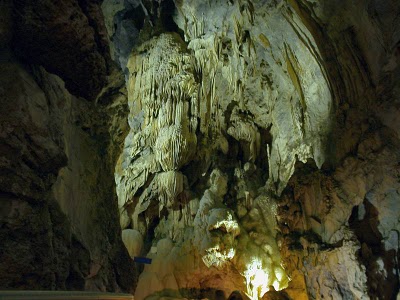
All the exokarst formations, They originate on the surface of the calcareous massif, by dissolution of the limestone or by subsidence, thus forming the canyons. These are spectacular, deep valleys with vertical walls, due to dissolution of the limestone, the dissolution is greater in the valleys than in the walls. We have sinkholes, depressions in the ground that are almost always circular, formed when rocks dissolve or when the roof of a cave collapses. Related to the sinkholes are the poljés, depressions of several km. The sinks are holes in the surface of the land, through which the water penetrates into the calcareous massif. In the sinkholes a stream can disappear and appear several km. later, in an upwelling. Surgence is a place where groundwater goes outside.
The lenar is a set of channels, produced by wild waters. Travertines or calcareous tuffs are formed by calcium carbonate precipitations on plants.
Endokarst formations They originate inside the calcareous massif, due to the action of the infiltrated water from the surface, through the circulation of the water, caves, grottos, large cavities are originated, in them there are chasms, which are vertical conduits inside the calcareous massif, the horizontal duct galleries, form an intricate network. When part of the roof is detached, they form galleries, called caverns. When mineral salts, calcium carbonate, are deposited in the cavities they are called speleothems, having several types.
Stalactites are calcium carbonate deposits that hang from the ceiling of galleries or caves.
Stalagmites are formed on the ground by the accumulation of drops of water falling from the ceiling, both have very slow growth, taking many centuries to form a few cm.
When a stalagmite and a stalactite come together they form a column, the curtains another of the spectacular formations are formed by the movement of water on the ceiling.